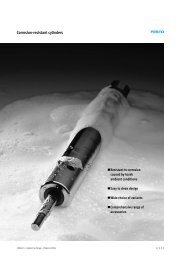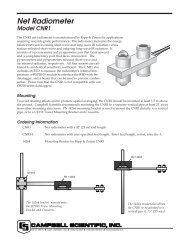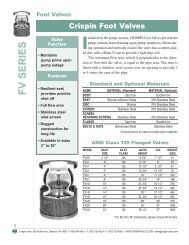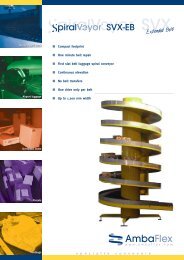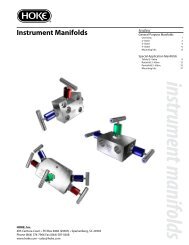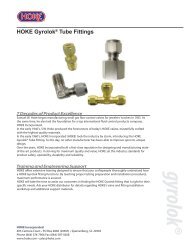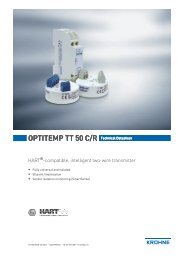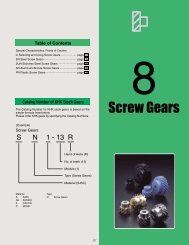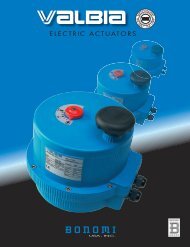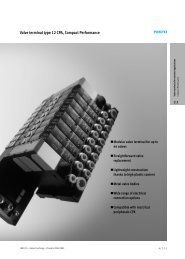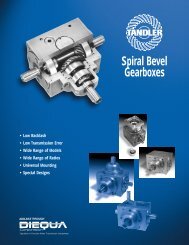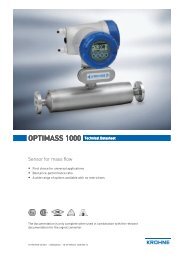EAS-element clutch - Mayr
EAS-element clutch - Mayr
EAS-element clutch - Mayr
- No tags were found...
Create successful ePaper yourself
Turn your PDF publications into a flip-book with our unique Google optimized e-Paper software.
<strong>EAS</strong> ® -<strong>element</strong> <strong>clutch</strong><br />
<strong>EAS</strong> ® -<strong>element</strong>s<br />
www. .com<br />
●<br />
●<br />
●<br />
●<br />
Immediate separation in case of overload<br />
For high speeds and long run-out times<br />
High switch-off and repetitive accuracies<br />
Integration into existing constructions possible<br />
K.440.V09.GB<br />
your reliable partner
<strong>EAS</strong> ® -<strong>element</strong> <strong>clutch</strong>/<strong>EAS</strong> ® -<strong>element</strong><br />
Non-destructive Overload Protection<br />
In heavy-duty machine building and on drives with<br />
high torques, high speeds and high mass moments<br />
of inertia, disengaging <strong>element</strong> <strong>clutch</strong>es guarantee<br />
that the input and the output are separated<br />
completely in the event of a collision or a malfunction,<br />
and that the stored rotational energy can slow<br />
down freely. In contrast to shear pins and hydraulic<br />
clamping sets, these <strong>clutch</strong>es work in a nondestructive<br />
way and are therefore an interesting and<br />
economical alternative.<br />
<strong>EAS</strong> ® -<strong>element</strong>s<br />
If the set circumferential force is exceeded in case of<br />
overload, the <strong>EAS</strong> ® -<strong>element</strong>s disengage; the positivelocking<br />
connection is interrupted.<br />
r<br />
r<br />
r<br />
r<br />
r<br />
Torque and force-limiting <strong>element</strong>s<br />
Residual torque-free separation of input and output<br />
in case of overload<br />
Mechanical re-engagement or re-engagement via<br />
pneumatic or hydraulic devices<br />
Fast and easy repeat operation start-up without<br />
using replacement parts<br />
Exact torque adjustment<br />
<strong>EAS</strong> ® -<strong>element</strong> <strong>clutch</strong><br />
The <strong>EAS</strong> ® -<strong>element</strong> <strong>clutch</strong> is based on individual overload<br />
<strong>element</strong>s (<strong>EAS</strong> ® -<strong>element</strong>s), which are integrated<br />
into hubs and flanges. The functional principle only<br />
allows low-backlash designs. Due to the modular<br />
structure, integration into existing constructions<br />
provided by the customer and ensuring of very high<br />
torques are possible.<br />
r<br />
r<br />
r<br />
r<br />
Torque limitation for heavy and high-speed drives<br />
in connection with large rotating masses, which<br />
have to slow down freely in case of overload<br />
Designs for direct attachment of drive <strong>element</strong>s<br />
Combinations with torsionally flexible couplings to<br />
connect two shafts and to compensate for shaft<br />
misalignments<br />
Extremely compact design as the perfect alternative<br />
to hydraulic clamping sets and shear pins
<strong>EAS</strong> ® -<strong>element</strong> <strong>clutch</strong>/<strong>EAS</strong> ® -<strong>element</strong><br />
<strong>EAS</strong> ® -<strong>element</strong>s<br />
Contents<br />
<strong>EAS</strong> ® -<strong>element</strong>s<br />
Page<br />
Description 4<br />
Summary of Constructional Designs 5<br />
Data Sheets<br />
• <strong>EAS</strong> ® -<strong>element</strong> Standard Sizes 02 – 01 6/7<br />
• <strong>EAS</strong> ® -<strong>element</strong> Standard Sizes 0 – 2 6/7<br />
• <strong>EAS</strong> ® -<strong>element</strong> Reinforced Sizes 0 – 2 6/7<br />
• Technical Explanations 8/9<br />
<strong>EAS</strong> ® -<strong>element</strong> <strong>clutch</strong> (Standard)<br />
<strong>EAS</strong> ® -<strong>element</strong> <strong>clutch</strong><br />
Torque range: 0,25 to 190 kNm<br />
Description 10<br />
Summary of Constructional Designs 11<br />
Data Sheets<br />
• <strong>EAS</strong> ® -<strong>element</strong> <strong>clutch</strong> flange design 12/13<br />
• <strong>EAS</strong> ® -<strong>element</strong> <strong>clutch</strong><br />
short bearing-supported hub 12/13<br />
• <strong>EAS</strong> ® -<strong>element</strong> <strong>clutch</strong> divisible positive locking 14/15<br />
• Technical Explanations 16-18<br />
<strong>EAS</strong> ® -special designs<br />
Special designs<br />
• <strong>EAS</strong> ® -<strong>element</strong> <strong>clutch</strong> (Example 1) 19<br />
• <strong>EAS</strong> ® -<strong>element</strong> <strong>clutch</strong> (Example 2) 19<br />
• <strong>EAS</strong> ® -<strong>element</strong> <strong>clutch</strong> (Example 3) 19<br />
Please Observe<br />
<strong>EAS</strong> ® -dutytorque<br />
Perfect protection for extruders<br />
For detailed information, detailed Technical Data and<br />
Dimensions, please see our Catalogue K.4043.V__
<strong>EAS</strong> ® -<strong>element</strong><br />
High Torque, Small Element - <strong>EAS</strong> ® -<strong>element</strong><br />
Characteristics<br />
r The torques on large <strong>clutch</strong>es are limited<br />
r<br />
r<br />
Suitable for retrofitting into<br />
existing constructions<br />
Using <strong>EAS</strong> ® -<strong>element</strong>s, customer-specific<br />
special requirements can be catered for<br />
Application<br />
r<br />
r<br />
r<br />
Also suitable for turntable and<br />
slew ring drives etc.<br />
Load securement, even in inclined<br />
or linear operation<br />
Even the largest torques are rendered<br />
manageable due to the application of as<br />
many <strong>EAS</strong> ® -<strong>element</strong>s as necessary<br />
Advantages/Benefits<br />
r<br />
r<br />
r<br />
On overload, the entire system can be<br />
stopped by a speed monitor<br />
<strong>EAS</strong> ® -<strong>element</strong>s allow a multitude<br />
of individual requirements<br />
The most cost-effective alternative<br />
in the field of large <strong>clutch</strong>es<br />
r Simple adjustment (force/torque)<br />
Rustproof design<br />
available on request<br />
Functional Principle of the <strong>EAS</strong> ® -<strong>element</strong><br />
r<br />
r<br />
r<br />
r<br />
If the circumferential force per <strong>element</strong> is too large, the resulting<br />
axial force causes an axial movement of the bolt via the ball/<br />
calotte system and therefore disconnects the torque transmission.<br />
The maximum circumferential force is determined individually via<br />
the adjusting nut and the mayr ® -cup springs. This limits the<br />
transmittable torque.<br />
Due to the axial stroke of the bolt (ball carrier), the control<br />
segments move radially outwards, thereby disconnecting the<br />
components axially.<br />
The ball is re-engaged via a bolt stroke in the direction of the<br />
calotte, either manually or via a mayr ® re-engagement device.<br />
Engaged<br />
Disengaged
<strong>EAS</strong> ® -<strong>element</strong><br />
<strong>EAS</strong> ® -<strong>element</strong>s Summary of Constructional Designs<br />
<strong>EAS</strong> ® -<strong>element</strong> Standard<br />
Sizes 02 – 01<br />
Type 440._04.0<br />
Pages 6/7<br />
<strong>EAS</strong> ® -<strong>element</strong> Standard<br />
Sizes 0 – 2<br />
Type 440._04.0<br />
• Torque or force-limiting <strong>element</strong>s<br />
for installation into two bearingsupported<br />
flanges facing each<br />
other or for integration into existing<br />
constructions.<br />
• In case of overload, the <strong>EAS</strong> ® -<br />
<strong>element</strong>s separate the input and<br />
output mechanically, so that the<br />
system can slow down freely.<br />
<strong>EAS</strong> ® -<strong>element</strong> Reinforced<br />
Sizes 0 – 2<br />
Type 441.604.0<br />
Pages 6/7<br />
• It is possible to transmit larger<br />
torques using the same<br />
installation size. Especially<br />
recommended for narrow<br />
installation conditions.<br />
Pages 6/7
<strong>EAS</strong> ® -<strong>element</strong><br />
Standard<br />
a 1<br />
Stroke<br />
Type 440._04.0<br />
Sizes 02 to 01<br />
Øt<br />
L 1<br />
l<br />
l<br />
v<br />
Øt<br />
e<br />
ØA 1<br />
s<br />
Ød 0<br />
ØA<br />
Øn<br />
SW<br />
y 1<br />
l 1<br />
y 2<br />
L<br />
Øn<br />
L 1<br />
L 2<br />
Stroke<br />
Type 440._04.0<br />
Sizes 0 to 2<br />
l<br />
L<br />
l 2<br />
Øt<br />
s<br />
s 1<br />
l<br />
v<br />
s<br />
60°<br />
(6x)<br />
30°<br />
ØA 2<br />
Ød 1<br />
S<br />
Ød 0<br />
ØA<br />
ØA 2<br />
30°<br />
Øn<br />
SW<br />
ØM<br />
ØA 0<br />
y 1<br />
l 1<br />
b<br />
y 2<br />
a 1<br />
Øm<br />
ØA 1<br />
Reinforced Type 441.604.0<br />
Sizes 0 to 2<br />
L 1<br />
L 2<br />
l<br />
L<br />
Stroke<br />
l 2<br />
30°<br />
30°<br />
Øn<br />
ØM<br />
ØA 0<br />
Øt<br />
s<br />
ØA 2<br />
Ød 1<br />
s 1<br />
S<br />
Ød 0<br />
ØA<br />
y 1<br />
l 1<br />
b<br />
y 2<br />
a 1<br />
l<br />
v<br />
ØA 2<br />
s<br />
SW<br />
Øm<br />
ØA 1<br />
60°<br />
(6x)
<strong>EAS</strong> ® -<strong>element</strong><br />
Technical Data<br />
Circumferential<br />
force<br />
Axial force<br />
Type 440.404.0<br />
(Low torque range)<br />
Type 440.504.0<br />
(Medium torque range)<br />
Type 440.604.0<br />
(High torque range)<br />
Type 441.604.0<br />
Reinforced design<br />
Type 440.404.0<br />
(Low torque range)<br />
Type 440.504.0<br />
(Medium torque range)<br />
Type 440.604.0<br />
(High torque range)<br />
Type 441.604.0<br />
Reinforced design<br />
02 01 0 1 2<br />
F u min [kN] 0,22 1 1,8 5 4<br />
Size<br />
F u max [kN] 0,54 2 5 10 11<br />
F u min [kN] 0,5 1,25 3,75 7,5 10<br />
F u max [kN] 1,4 2,5 7,5 15 30<br />
F u min [kN] 1,2 2,5 7,5 15 30<br />
F u max [kN] 2,5 5 15 30 60<br />
F u min [kN] - - 19 38 75<br />
F u max [kN] - - 38 75 150<br />
F ax min [kN] 0,2 0,9 1,62 4,5 3,6<br />
F ax max [kN] 0,48 1,8 4,5 9 9,9<br />
F ax min [kN] 0,45 1,12 3,37 6,75 9<br />
F ax max [kN] 1,26 2,25 6,75 13,5 27<br />
F ax min [kN] 1,08 2,25 6,75 13,5 27<br />
F ax max [kN] 2,25 4,5 13,5 27 54<br />
F ax min [kN] - - 10 20 40<br />
F ax max [kN] - - 20 40 80<br />
Bolt stroke on overload [mm] 2,5 4 6 8 12<br />
Weight [kg] 0,25 0,6 1,75 4,1 11,3<br />
Dim.<br />
[mm]<br />
Size<br />
02 01 0 1 2<br />
A H8<br />
h7 28 38 55 75 100<br />
A 0<br />
- - 85 110 150<br />
A 1<br />
28 35 55 75 100<br />
A 2<br />
- - 55 75 108<br />
a 1<br />
1,0 1,5 2 2 3<br />
b - - 12 15 20<br />
d 0<br />
10 14 20 30 40,6<br />
d 1<br />
H8<br />
h7 - - 30 40 60<br />
e 31,2 41,6 - - -<br />
L 28 40 73 96 160<br />
L 1<br />
15 21 52 65 80<br />
L 2<br />
- - 42 51 70<br />
I 12 15 30 40 50<br />
Dim.<br />
[mm]<br />
Size<br />
02 01 0 1 2<br />
I 1<br />
7 10 22 30 40<br />
I 2<br />
- - 12 17 22<br />
M - - 72 95 128<br />
m - - 44 60 80<br />
n 17 22 31 48 69<br />
S - - M12 M20 M24<br />
s M24x1 1) M30x1,5 2) M6 3) M8 4) M12 5)<br />
s 1<br />
- - M5 M6 M8<br />
SW 27 36 19 30 36<br />
t 3 4 5 6 8<br />
v 2 3 3 4 15<br />
y 1<br />
6)<br />
12 15 8 10 10<br />
y 2<br />
6)<br />
16 21 38 50 65<br />
<strong>EAS</strong> ® -<strong>element</strong> Standard<br />
Order Number<br />
__ / 4 4 0 . __ 0 4 . 0<br />
We reserve the right to make dimensional and constructional alterations.<br />
<strong>EAS</strong> ® -<strong>element</strong> Reinforced<br />
Order Number<br />
__ / 4 4 1 . 6 0 4 . 0<br />
Size<br />
02<br />
01<br />
0<br />
1<br />
2<br />
Torque range<br />
low<br />
medium<br />
high<br />
4<br />
5<br />
6<br />
Example: Order number 0 / 440.504.0<br />
Size<br />
0<br />
1<br />
2<br />
Example: Order number 0 / 441.604.0<br />
1) Tightening torque M A<br />
= 40 Nm<br />
2) Tightening torque M A<br />
= 60 Nm<br />
3) Fixing screw DIN EN ISO 4762 10.9 M A<br />
= 9 Nm<br />
4) Fixing screw DIN EN ISO 4762 10.9 M A<br />
= 19 Nm<br />
5) Fixing screw DIN EN ISO 4762 10.9 M A<br />
= 76 Nm<br />
6) y 1<br />
and y 2<br />
are extension dimensions
<strong>EAS</strong> ® -<strong>element</strong><br />
Function:<br />
13<br />
10 8<br />
2<br />
3 4 5 6 7 1 11 12<br />
<strong>EAS</strong> ® -<strong>element</strong>s for installation in two bearing-supported flanges<br />
facing each other or for integration into existing constructions.<br />
The <strong>EAS</strong> ® -<strong>element</strong>s are available in 5 sizes (02 – 2).<br />
In case of overload, the <strong>EAS</strong> ® -<strong>element</strong>s separate the input and<br />
output mechanically, so that the system can slow down freely.<br />
Re-engagement of the individual <strong>element</strong>s is carried out by hand<br />
(automatic re-engagement available on request).<br />
Stroke<br />
Torque Path:<br />
r<br />
Flange A (customer-side) – bolt 1 – balls 3 – thrust piece 2 – flange B<br />
(customer-side).<br />
13<br />
10 8<br />
B<br />
Fig. 1: <strong>EAS</strong> ® -<strong>element</strong> engaged<br />
A<br />
2<br />
Design<br />
Sizes 0 – 1<br />
3 4 5 6 7 1<br />
Design<br />
Size 2<br />
Processes for Torque Switch-off on Overload:<br />
On overload, the two flanges A and B begin to turn against each<br />
other. Bolt 1 is pressed via the control segments 4 and the thrust<br />
washer 5 against the force of the cup springs 6 from the thrust<br />
pieces 2. The control segments 4 travel radially outwards over the<br />
bolt 1 switching edge and hold bolt 1 in a disengaged position (see<br />
Fig. 2). The positive-locking connection of the two <strong>clutch</strong> flanges<br />
A and B is nullified. The originally coupled masses can slow down<br />
freely. The drive is switched off electrically via a speed monitoring<br />
device 13.<br />
Design:<br />
All <strong>element</strong> components consist of high-quality quenched and<br />
tempered steels with a zinc-phosphated surface which provides<br />
a basic corrosion protection for further surface treatments.<br />
B<br />
Fig. 2: <strong>EAS</strong> ® -<strong>element</strong> disengaged<br />
A<br />
The bolt 1, the thrust pieces 2, the ball 3, the control segments 4 and<br />
the thrust washers 5 are hardened. The ball 3 is supported in bolt 1.<br />
It can be rotated and is secured against falling out.<br />
The <strong>element</strong>s are also suitable for oil-running.<br />
M G<br />
= z × F u<br />
× r [kNm]<br />
Size Selection:<br />
The limit torque for overload M G<br />
on a <strong>clutch</strong> composed of <strong>element</strong>s<br />
can be calculated as follows:<br />
M G<br />
F u<br />
r<br />
= Limit torque for overload in [kNm]<br />
=<br />
=<br />
Circumference force per <strong>element</strong> in [kN]<br />
(see Dimensions Sheets)<br />
Pitch circle radius onto which the <strong>element</strong>s<br />
are mounted in [m] (see Fig. 1)<br />
z = Number of <strong>element</strong>s [-]<br />
Re-engagement:<br />
F E<br />
Re-engagement is carried out by applying axial pressure on the<br />
bold end. The level of engagement force F E<br />
is dependent on the<br />
set circumferential force F u<br />
and can be roughly calculated using the<br />
following formula.<br />
For <strong>element</strong> Type 440._04.0<br />
F E<br />
= 0,12 × F u<br />
[kN]<br />
Fig. 3<br />
B<br />
A<br />
For <strong>element</strong> Type 441.604.0<br />
F E<br />
= 0,08 × F u<br />
[kN]<br />
The engagement procedure can be automated or operated by remote<br />
control when using mechanical, pneumatic or hydraulic aids.<br />
F E<br />
F u<br />
= Engagement force per overload <strong>element</strong> in [kN]<br />
= Set circumference force in [kN]
<strong>EAS</strong> ® -<strong>element</strong><br />
10 8 9 2 3 4 5 6 7 1 11 12<br />
14 2<br />
B<br />
B<br />
A<br />
a 1<br />
p<br />
a 1<br />
p<br />
<strong>EAS</strong> ® -<strong>element</strong><br />
A<br />
Design<br />
Sizes 0 – 1<br />
Fig. 4: <strong>EAS</strong> ® -<strong>element</strong> Sizes 0 – 2<br />
Fig. 5: <strong>EAS</strong> ® -<strong>element</strong> Sizes 02 – 01<br />
Alternative<br />
pre-tensioning<br />
using shim rings<br />
Size<br />
Design<br />
Size 2<br />
Pre-tensioning<br />
using shim rings<br />
02 01 0 1 2<br />
Inspection dim. p [mm] 3,5 5,5 8,0 10,5 15,5<br />
Distance dim. a 1<br />
[mm] 1,0 1,5 2,0 2,0 3,0<br />
Bolt pre-tension [mm] 0,2 0,2 0,5 0,6 0,6<br />
Installation of the <strong>EAS</strong> ® -<strong>element</strong>s, Sizes 02 – 2:<br />
❒<br />
❒<br />
❒<br />
❒<br />
❒<br />
❒<br />
❒<br />
❒<br />
The adaptor bores and the threaded holes for the <strong>EAS</strong> ® -<strong>element</strong>s<br />
must be produced according to the Dimension Sheets or the<br />
Installation and Operational Instructions B.4.4.GB.<br />
Before installation, please make sure that the <strong>element</strong>s are<br />
engaged. Measure the inspection dimension “p” according to the<br />
Table below. The <strong>element</strong>s are delivered in an engaged position<br />
ex works.<br />
Install the <strong>EAS</strong> ® -<strong>element</strong> into flange A. Please observe the<br />
tightening torque M A<br />
according to the details in the Dimension<br />
Sheets.<br />
Grease the thrust piece 2 (Fig. 4) or the adaptor bushing 14<br />
(Fig. 5) well (Please use: grease NLGI class 2 with a basic oil<br />
viscosity of 220 mm 2 /s at 40 °C, e.g. Mobilgrease HP222) and<br />
insert in or screw onto flange B. The set screw 9 must be removed.<br />
Screw-on the cover 10. The set screw 8 must be removed. Please<br />
observe the tightening torque M A<br />
according to the details given<br />
in the Dimension Sheets.<br />
Adjust the distance dimension a 1<br />
according to Table 1 below.<br />
Pre-tensioning the <strong>element</strong>s on Sizes 0 – 2:<br />
Tighten the set screw 8. After adjustment, counter the set screw 8.<br />
For operation with impact and vibration occurrences it is<br />
recommended to carry out the bolt pre-tensioning<br />
alternatively by inserting shim rings.<br />
Secure thrust piece 2 using set screw 9.<br />
Pre-tensioning the <strong>element</strong>s on Sizes 02 – 01:<br />
Insert shim rings between the adaptor bushing and the thrust piece.<br />
(see Installation and Operational Instructions B.4.4.GB).<br />
Record the set distance dimension a 1<br />
for subsequent<br />
inspections (the set adjustment dimension is calculated as<br />
follows: Distance dimension a 1<br />
- bolt pre-tension).<br />
Torque Adjustment:<br />
The limit torque for overload on the <strong>clutch</strong> is adjusted by changing<br />
the cup spring pre-tension of each <strong>element</strong>. For Sizes 02 – 1,<br />
adjustment is carried out via the adjusting nut 7, for Size 2 via 4 set<br />
screws 11 (Fig. 4). All 4 set screws must be evenly adjusted and<br />
countered. During torque adjustment, it is essential that all <strong>element</strong>s<br />
on the <strong>clutch</strong> are adjusted evenly.<br />
The <strong>EAS</strong> ® -<strong>element</strong>s can be set to the required circumferential<br />
force F U<br />
at the place of manufacture. Subsequent adjustment or<br />
re-adjustment via adjustment curves is also possible (see Installation<br />
and Operational Instructions B.4.4.GB).<br />
Table 1<br />
Inspection Intervals:<br />
For <strong>element</strong> Type 440._04.0: c. 1 year or after every 1.000<br />
disengagements.<br />
For <strong>element</strong> Type 441.604.0: c. 1 year or after every 100<br />
disengagements.<br />
Should the device be subject to very dirty, dusty or extreme ambient<br />
conditions, it may be necessary to carry out inspections at much<br />
shorter intervals. If the distance dimension a 1<br />
increases substantially<br />
(see Table 2), the axial bearing of both <strong>clutch</strong> flanges must be<br />
checked.<br />
Maintenance:<br />
The <strong>EAS</strong> ® -<strong>element</strong>s are completely enclosed and have a grease<br />
filling, meaning that they are mainly maintenance-free.<br />
Maintenance work on the <strong>clutch</strong> is limited to the following:<br />
❒<br />
❒<br />
After the first 20 disengagements, check the <strong>clutch</strong> circumferential<br />
backlash and the originally set adjustment dimension “a 1<br />
”; if<br />
necessary, re-adjust the bolt pre-tension.<br />
Re-grease the contact components and thrust pieces (2).<br />
<strong>EAS</strong> ® -<strong>element</strong><br />
Distance dimension<br />
a 1<br />
increase<br />
Size<br />
02 01 0 1 2<br />
[mm] 0,1 0,1 0,3 0,4 0,4<br />
For greasing, use an NLGI Class 2 grease with a basic oil viscosity<br />
of 220 mm 2 /s at 40°C, e.g. Mobilgrease HP222.<br />
These inspections and re-greasing of the contact components and<br />
thrust pieces (2) are also necessary later during routine inspections.<br />
Table 2
<strong>EAS</strong> ® -<strong>element</strong> <strong>clutch</strong><br />
The High-Torque-<strong>EAS</strong> ® -<strong>element</strong> Clutch<br />
Characteristics<br />
r Designed for high torques<br />
r As standard design up to 190.000 Nm<br />
r Available with torque adjustment<br />
r Individual constructional design<br />
according to the customer’s requests<br />
r In case of overload, the drive is<br />
switched off via a speed monitor<br />
r Large and expensive heavy-duty<br />
machines are protected reliably<br />
against damage due to overload<br />
Application<br />
Used for example in:<br />
r Shovel excavators<br />
r Dredgers<br />
r Turbine construction<br />
r Water lock drives<br />
r Rolling mills<br />
r Steel plants<br />
Advantages/Benefits<br />
r Avoids downtimes<br />
r Increases the availability<br />
r Increases the production capacity<br />
Rustproof design<br />
available on request<br />
Functional Principle of the <strong>EAS</strong> ® -<strong>element</strong> <strong>clutch</strong><br />
Overload <strong>element</strong>s<br />
❒<br />
❒<br />
❒<br />
❒<br />
If the circumferential force per <strong>element</strong> is too large, the resulting<br />
axial force causes an axial movement of the bolt via the ball/<br />
calotte system and therefore a disconnection of the torque<br />
transmission.<br />
The maximum circumferential force is determined individually via<br />
the adjusting nut and the mayr ® cup springs. This determines the<br />
transmittable torque.<br />
Due to the axial stroke of the bolt (ball carrier), the control<br />
segments move radially outwards, thereby disconnecting the<br />
components axially.<br />
The ball is re-engaged via a bolt stroke in the direction of the<br />
calotte, either manually or via a mayr ® re-engagement device<br />
(pneumatic, hydraulic, electromechanical or mechanical).<br />
Engaged<br />
Disengaged<br />
10
<strong>EAS</strong> ® -<strong>element</strong> <strong>clutch</strong><br />
<strong>EAS</strong> ® -<strong>element</strong> <strong>clutch</strong> Summary of Constructional Designs<br />
<strong>EAS</strong> ® -<strong>element</strong> <strong>clutch</strong><br />
Flange design<br />
Torque:<br />
0,25 to 190 kNm<br />
Sizes 6 to 14<br />
Type 400._04.0<br />
The <strong>clutch</strong> thrust piece can be integrated into the bearingsupported<br />
drive <strong>element</strong>; the hub part (with the installed<br />
<strong>EAS</strong> ® -<strong>element</strong>s) can be secured onto the shaft.<br />
• Torque limitation for heavy and high-speed drives in<br />
connection with large rotating masses, which have to slow<br />
down freely in case of overload.<br />
• Flange design for the attachment of sprocket wheels and<br />
toothed wheels, V-belt disks etc.<br />
• The respective <strong>element</strong> bearings on the shaft must be<br />
provided customer-side.<br />
<strong>EAS</strong> ® -<strong>element</strong> <strong>clutch</strong><br />
Short bearing-supported hub<br />
Torque:<br />
0,25 to 190 kNm<br />
Sizes 6 to 14<br />
Type 400._04.5<br />
Pages 12/13<br />
On this design, the drive <strong>element</strong> can be mounted directly onto<br />
the bearing-supported, output-side <strong>clutch</strong> flange.<br />
The bearing is able to absorb high additional forces in axial and<br />
radial directions. However, the maximum permitted forces on<br />
the flange connection in radial and axial directions must not be<br />
exceeded (see Technical Data, page 13).<br />
•<br />
•<br />
Torque limitation with integrated output-side bearing<br />
Drive <strong>element</strong>s such as sprocket wheels and toothed<br />
wheels, V-belt disks etc. can be mounted directly without<br />
requiring an additional bearing position.<br />
See Installation Example, Fig. 2, page 17<br />
<strong>EAS</strong> ® -<strong>element</strong> <strong>clutch</strong><br />
Divisible positive locking<br />
Torque:<br />
0,25 to 190 kNm<br />
Sizes 6 to 14<br />
Type 435._04.5<br />
Pages 12/13<br />
<strong>EAS</strong> ® -<strong>element</strong> <strong>clutch</strong> in combination with a positive-locking,<br />
flexible coupling part for the connection of two shafts.<br />
On Sizes 6 – 11 the flexible coupling part is produced as a<br />
positive-locking claw coupling with replaceable intermediate<br />
ring made from highly damping, oil-resistant and temperature<br />
resistant material (Fig. 1).<br />
On Sizes 12 – 14 a claw coupling with radially mountable,<br />
large-volume, flexible buffers is used (Fig. 2). Replacing the<br />
flexible buffers is possible without <strong>clutch</strong> disassembly.<br />
• Torque limitation with a positive-locking, torsionally flexible<br />
coupling for the connection of two shafts.<br />
• The flexible coupling is insertable axially, compensates for<br />
shaft misalignments and has a damping effect on impacttype<br />
loads.<br />
Fig. 1<br />
Fig. 2<br />
Pages 14/15<br />
11
<strong>EAS</strong> ® -<strong>element</strong> <strong>clutch</strong><br />
Flange Design<br />
Type 400._04.0<br />
Sizes 6 to 14<br />
Øf 5<br />
Øe 1<br />
Ød 2<br />
s 2<br />
Øm 1<br />
s 1<br />
l 2<br />
L 2<br />
a 1<br />
z 1<br />
b 8<br />
b 4<br />
b 3<br />
Stroke<br />
l<br />
Ød<br />
Øf 2<br />
ØM<br />
ØF<br />
Short bearing-supported hub<br />
Type 400._04.5<br />
L<br />
Sizes 6 to 14<br />
z<br />
b<br />
Stroke<br />
b 4<br />
b 3<br />
Øf 1<br />
Øm<br />
Øe<br />
Ød 0<br />
Ød<br />
Øf 2<br />
ØM<br />
ØF<br />
s<br />
l<br />
b 1<br />
Order Number<br />
__ / 4 0 0 . __ 0 4 . __ / __ / __<br />
Size<br />
6<br />
to<br />
14<br />
Torque range 1)<br />
low<br />
medium<br />
high<br />
4<br />
5<br />
6<br />
Desing<br />
Flange design<br />
Short bearing-supported<br />
hub<br />
0<br />
5<br />
Bore 2)3)<br />
Ø d H7<br />
(dependent on size<br />
< = d max<br />
)<br />
Bore<br />
Ø d 0<br />
(dependent on size < = d 0 max<br />
)<br />
Example: Order number 8 / 400.604.0 / 95 /<br />
1) See Technical Data, limit torque for overload M G<br />
2) On Type 400._04.0: Position of the keyway to the tapped hole “s 2<br />
” in the thrust piece is not defined. Defined position available on request.<br />
3) On Type 400._04.5: Position of the keyway to the tapped hole “s” in the thrust piece is not defined. Defined position available on request.<br />
12
<strong>EAS</strong> ® -<strong>element</strong> <strong>clutch</strong><br />
Technical Data<br />
Limit torques<br />
for overload<br />
<strong>EAS</strong> ® -<strong>element</strong><br />
Type 400.404._<br />
(Low torque range)<br />
Type 400.504._<br />
(Medium torque range)<br />
Type 400.604._<br />
(High torque range)<br />
6 7 8 9 10 11 12 13 14<br />
M G min [kNm] 0,25 0,45 0,75 2,0 3,3 6,3 4 7,6 12,5<br />
M G max [kNm] 0,7 1,3 2,1 4,0 6,6 12,6 11 21 34,5<br />
M G min [kNm] 0,55 1,0 1,625 3,0 5 9,5 10 19 31,5<br />
M G max [kNm] 1,1 2,0 3,25 6,0 10 19 30 57,5 95<br />
M G min [kNm] 1,1 2,0 3,25 6,0 10 19 30 57,5 95<br />
M G max [kNm] 2,2 4,0 6,5 12 20 38 60 115 190<br />
Size 0 0 0 1 1 1 2 2 2<br />
Pieces 2 3 4 3 4 6 4 6 8<br />
Maximum speed n max [rpm] 3500 3000 2800 2500 2200 2000 1800 1500 1200<br />
Bolt stroke on overload [mm] 6 6 6 8 8 8 12 12 12<br />
Max. permitted Forces 1) Size<br />
on the Flange Connection<br />
6 7 8 9 10 11 12 13 14<br />
Radial forces<br />
F R [kN] 30 45 60 90 120 180 240 360 480<br />
Type 400._04.5<br />
Axial forces F A [kN] 21 31,5 42 63 84 126 168 252 336<br />
Mass Moment of Inertia and Weight<br />
Size<br />
Size<br />
6 7 8 9 10 11 12 13 14<br />
Hub-side Type 400._04._ J [kgm²] 0,09 0,16 0,31 0,95 1,96 4,01 11,10 26,5 60,9<br />
Flange-side Type 400._04.5 J [kgm²] 0,10 0,19 0,41 1,34 2,79 6,41 14,97 40,2 103<br />
Weight at d max<br />
Type 400._04.0 [kg] 13,4 18,6 28,4 57,6 84,3 119 223 355 631<br />
Type 400._04.5 [kg] 31 46 70 140 212 320 550 900 1650<br />
Bores [mm]<br />
Size<br />
6 7 8 9 10 11 12 13 14<br />
Hub-side Type 400._04._ d max<br />
70 90 110 135 160 200 250 300 350<br />
Flange-side Type 400._04.5 d 0 max<br />
25 30 40 48 58 85 95 110 140<br />
Dim.<br />
[mm]<br />
Size<br />
6 7 8 9 10 11 12 13 14<br />
a 1<br />
2 2 2 2 2 2 3 3 3<br />
b 20 25 30 35 35 40 45 50 50<br />
b 1<br />
58 68 78 94 110 122 134 170 192<br />
b 3<br />
43 43 43 56 56 56 110 110 110<br />
b 4<br />
44 44 44 56 56 56 70 70 75<br />
b 8<br />
14 14 14 16 16 16 20 20 25<br />
d 2<br />
30 30 30 40 40 40 60 60 60<br />
e 1<br />
H7<br />
98 123 150 190 240 290 350 430 480<br />
e h7<br />
136 147 165 242 276 380 385 430 600<br />
F 230 260 304 380 450 535 660 800 960<br />
f 1<br />
210 238 280 360 418 504 606 740 900<br />
f 2<br />
96 120 150 190 220 260 320 390 500<br />
f 5<br />
212 240 282 362 420 506 609 743 903<br />
L 189 228 270 330 387 441 508 599 686<br />
L 2<br />
127 158 188 231 271 311 366 418 485<br />
I 110 140 170 210 250 290 340 390 450<br />
l 2<br />
22 22 22 30 30 30 40 40 40<br />
M 2) 155 180 225 270 340 425 505 640 795<br />
m 175 190 220 285 325 430 500 600 750<br />
m 1<br />
84 110 130 157 190 240 290 350 400<br />
s 8xM12 8xM16 8xM20 8xM24 12xM24 12xM27 12xM30 12xM36 16xM36<br />
s 1<br />
8xM8 8xM10 8xM12 8xM16 8xM16 12xM16 12xM20 16xM24 16xM24<br />
s 2<br />
M6 M6 M6 M6 M6 M6 M8 M8 M8<br />
z 4 4 4 5 6 8 8 10 10<br />
z 1<br />
3 4 4 5 5 5 6 8 10<br />
We reserve the right to make dimensional and<br />
constructional alterations.<br />
1) Line of influence of the radial force at the<br />
screw-on level.<br />
2) Type 400._04.0: Tolerance for installation<br />
of the thrust pieces (customer-side):<br />
Sizes 6 – 8 ±0,03; Sizes 9 – 14 ±0,05<br />
13
<strong>EAS</strong> ® -<strong>element</strong> <strong>clutch</strong><br />
Divisible positive locking<br />
Type 435._04.5<br />
Sizes 6 to 14<br />
Stroke<br />
l 1<br />
l<br />
b 4<br />
1) See Technical Data, limit torque for overload M G<br />
a<br />
b 1<br />
Order Number<br />
Size Torque range 1)<br />
6 low<br />
4<br />
to medium<br />
5<br />
14 high<br />
6<br />
Example: Order number 9 / 435.504.5 / 110 / 130 / 45<br />
Øf 3<br />
Øf 4<br />
Ød 1<br />
L 1<br />
b 7<br />
b 6<br />
b 3<br />
Ød 0<br />
Ød<br />
__ / 4 3 5 . __ 0 4 . 5 / __ / __ / __<br />
Bore<br />
Ø d H7<br />
(dependent on<br />
size < = d max<br />
)<br />
Øf 2<br />
ØM<br />
For Dimensioning the Flexible Coupling Part, please see Pages 17/18.<br />
ØF<br />
Bore<br />
Ø d 1<br />
H7<br />
(dependent on<br />
size < = d 1 max<br />
)<br />
Bore<br />
Ø d 0<br />
(dependent on<br />
size < = d 0 max<br />
)<br />
14
<strong>EAS</strong> ® -<strong>element</strong> <strong>clutch</strong><br />
Technical Data<br />
Limit torques<br />
for overload<br />
<strong>EAS</strong> ® -<strong>element</strong><br />
Type 435.404.5<br />
(Low torque range)<br />
Type 435.504.5<br />
(Medium torque range)<br />
Type 435.604.5<br />
(High torque range))<br />
6 7 8 9 10 11 12 13 14<br />
M G min [kNm] 0,25 0,45 0,75 2,0 3,3 6,3 4 7,6 12,5<br />
M G max [kNm] 0,7 1,3 2,1 4,0 6,6 12,6 11 21 34,5<br />
M G min [kNm] 0,55 1,0 1,625 3,0 5 9,5 10 19 31,5<br />
M G max [kNm] 1,1 2,0 3,25 6,0 10 19 30 57,5 95<br />
M G min [kNm] 1,1 2,0 3,25 6,0 10 19 30 57,5 95<br />
M G max [kNm] 2,2 4,0 6,5 12 20 38 60 115 190<br />
Size 0 0 0 1 1 1 2 2 2<br />
Pieces 2 3 4 3 4 6 4 6 8<br />
Maximum speed n max [rpm] 3500 3000 2800 2500 2200 2000 1800 1500 1200<br />
Bolt stroke on overload [mm] 6 6 6 8 8 8 12 12 12<br />
Flexible shaft<br />
coupling<br />
Nominal and maximum torques,<br />
flexible coupling<br />
Permitted axial DK a<br />
[mm] ±2,0 ±2,0 ±2,5 ±2,5 ±2,5 ±2,5 ±0,5 ±0,7 ±0,7<br />
ments 1) angular DK w<br />
[º] 0,08 0,07 0,06 0,04 0,04 0,03 0,1 0,1 0,08<br />
misalign-<br />
radial DK r<br />
[mm] 0,3 0,3 0,3 0,3 0,3 0,3 0,55 0,55 0,65<br />
T KN [kNm] 1,5 2,4 3,7 8,9 13,2 27 45 65 120<br />
T K max [kNm] 3,1 4,8 7,5 18,2 27 54 135 176 380<br />
Size<br />
Mass Moments of Inertia and Weight<br />
Mass moments<br />
of inertia<br />
Size<br />
6 7 8 9 10 11 12 13 14<br />
Hub-side J [kgm²] 0,09 0,16 0,31 0,95 1,96 4,01 11,10 26,5 60,9<br />
Flexible side J [kgm²] 0,24 0,42 0,81 3,25 6,12 18,15 23,78 66,6 169,6<br />
Weight at d max<br />
[kg] 56 78 115 251 367 655 860 1440 2630<br />
Bores [mm]<br />
Size<br />
6 7 8 9 10 11 12 13 14<br />
Hub-side d max<br />
70 90 110 135 160 200 250 300 350<br />
Bearing flange d 0 max<br />
25 30 40 48 58 85 95 110 140<br />
Flexible side d 1 max<br />
95 100 115 160 180 240 200 250 320<br />
Dim.<br />
[mm]<br />
Size<br />
6 7 8 9 10 11 12 13 14<br />
a 4 4 5,5 8 8 8 12 13 13<br />
b 1<br />
58 68 78 94 110 122 134 170 192<br />
b 3<br />
43 43 43 56 56 56 110 110 110<br />
b 4<br />
44 44 44 56 56 56 70 70 75<br />
b 6<br />
62,5 66,5 76 94 102 108 60 73 80<br />
b 7<br />
75,6 80,6 91,7 111,3 119,3 130,5 118 131 147<br />
F 230 260 304 380 450 535 660 800 960<br />
f 2<br />
96 120 150 190 220 260 320 390 500<br />
f 3<br />
214 240 265 370 415 575 580 680 840<br />
f 4<br />
136 146 164 241 275 368 280 350 450<br />
L 1<br />
380,5 437,5 512 638 724 826 845 980 1161<br />
I 110 140 170 210 250 290 340 390 450<br />
I 1<br />
107 117 137 176 196 240 228 258 338<br />
M 155 180 225 270 340 425 505 640 795<br />
We reserve the right to make dimensional and<br />
constructional alterations.<br />
1) The values refer to 1500 rpm.<br />
15
Technical Explanations<br />
4<br />
3.2 3.3 3.4 3.5 3.6 3.7 3.1 3.11<br />
Design:<br />
All <strong>element</strong> components are made of steel, are machined on<br />
all sides and have a zinc-phosphated surface which provides<br />
a basic corrosion protection for further surface treatments.<br />
The design of the installed <strong>EAS</strong> ® -<strong>element</strong>s is as described on page 8.<br />
The <strong>clutch</strong> is also suitable for oil-running.<br />
2<br />
Stroke<br />
1<br />
Design Sizes 0 – 1<br />
Fig. 1: <strong>EAS</strong> ® -<strong>element</strong> <strong>clutch</strong> engaged<br />
Design<br />
Size 2<br />
Torque Adjustment:<br />
The limit torque for overload on the <strong>clutch</strong> can be adjusted by<br />
changing the cup spring pre-tension of each overload <strong>element</strong>. For<br />
Sizes 6 – 11, adjustment is carried out via the adjusting nut 3.7,<br />
for Sizes 12 – 14 via set screws 3.11 (see Fig. 1). It is essential<br />
that all overload <strong>element</strong>s on the <strong>clutch</strong> are adjusted evenly. The<br />
<strong>EAS</strong> ® -<strong>element</strong> <strong>clutch</strong>es Sizes 6 – 14 can be set to the required<br />
limit torque for overload at the place of manufacture. Subsequent<br />
adjustment or re-adjustment via an adjustment diagram is also<br />
possible (see Installation and Operational Instructions B.4.3.GB).<br />
4<br />
2<br />
Markings for<br />
re-engagement<br />
3.2 3.3 3.4 3.5 3.6 3.7 3.1<br />
1<br />
Torque Path:<br />
Hub part 1 – bolt 3.1 – balls 3.3 – thrust piece 3.2 - output flange 2<br />
Processes for Torque Switch-off on Overload:<br />
On overload, the hub part 1 and the output flange 2 begin to turn<br />
against each other. The bolts 3.1 in the overload <strong>element</strong>s are<br />
pressed via the control segments 3.4 against the force of the cup<br />
springs 3.6 from the thrust washers 3.2. The control segments 3.4<br />
travel radially outwards over the bolt 3.1 switching edge and hold<br />
bolt 3.1 in a disengaged position (see Fig. 2). The positive-locking<br />
connection of the hub part 1 and the output flange 2 is nullified.<br />
The originally coupled masses can slow down freely. The drive is<br />
switched off electrically via speed monitoring device 4.<br />
Fig. 2: <strong>EAS</strong> ® -<strong>element</strong> <strong>clutch</strong> disengaged<br />
F E<br />
= k × M G<br />
[kN]<br />
F E<br />
= Total engagement force for all <strong>clutch</strong> overload<br />
<strong>element</strong>s [kN] (see Fig. 3)<br />
k = Calculation factor [1/m] acc. Table 1<br />
M G<br />
= Set limit torque for overload in [kNm]<br />
<strong>EAS</strong> ® -Size<br />
6 7 8 9 10 11 12 13 14<br />
Re-engagement:<br />
Re-engagement is carried out by applying axial pressure on the bolt<br />
end 3.1 of each overload <strong>element</strong>. The hub part 1 and the output<br />
flange 2 are turned into the correct angular position to one another<br />
(re-engagement position can be recognized via the marking bores<br />
on the <strong>clutch</strong> outer diameter, Fig. 2). By hitting the bolt end with<br />
a plastic hammer, the bolts 3.1 are brought back into an engaged<br />
position. The <strong>clutch</strong> is ready for operation when all <strong>clutch</strong> overload<br />
<strong>element</strong>s are engaged. The level of engagement force is dependent<br />
on the set limit torque for overload and can be calculated roughly<br />
using the formula below.<br />
Re-engagement can also be carried out automatically using<br />
compressed air. If you are interested in this feature, please<br />
contact the manufacturer.<br />
Calculation<br />
factor k<br />
Table 1<br />
[1/m] 1,7 1,4 1,3 1,0 0,8 0,6 0,5 0,4 0,3<br />
Mounting onto the Shaft:<br />
In a standard delivery, the <strong>EAS</strong> ® -<strong>element</strong> <strong>clutch</strong>es Sizes 6 – 14 are<br />
delivered with a finish bore and a keyway acc. DIN 6885. The <strong>clutch</strong><br />
can be secured axially onto the shaft e.g. with a disk or a screw<br />
turned into the shaft threaded centre hole.<br />
Other shaft-hub connections, e.g. multi-splines, toothings,<br />
shrink fits, pressurised oil assemblies etc. are also possible.<br />
F E<br />
16<br />
Fig. 3
Technical Explanations<br />
Thrust piece<br />
Air gap a 1<br />
Maintenance<br />
The <strong>EAS</strong> ® -<strong>element</strong> <strong>clutch</strong>es Sizes 6 – 14 do not require special<br />
maintenance work. They are largely protected against dust and<br />
humidity, they have a first grease-filling and are therefore mainly<br />
maintenance-free.<br />
Fig. 1<br />
The distance dimension a 1<br />
between the thrust piece and the<br />
overload <strong>element</strong> facing side is set manufacturer-side and does not<br />
require any re-adjustment (Fig. 1). Should the device be subject to<br />
very dirty, dusty or extreme ambient conditions, it may be necessary<br />
to carry out special maintenance work.<br />
In this case, please contact the manufacturer.<br />
Installation Example<br />
Connecting the drive <strong>element</strong>s as shown in Fig. 2 means better<br />
distribution of the radial and axial forces on the bearing. In this case,<br />
the resulting radial force of the drive <strong>element</strong> lies approximately in<br />
the bearing centre.<br />
For this design, please contact the manufacturer.<br />
Fig. 2<br />
Dimensioning the Flexible Coupling Part Type 435._04.5<br />
∆K a<br />
Shaft Misalignments<br />
Axial displacement<br />
∆K w<br />
∆K r<br />
Radial misalignment<br />
Flexible coupling for the compensation of axial, radial and angular<br />
shaft misalignments.<br />
The misalignment possibilities of the flexible coupling are general<br />
guideline values, which can be regarded as adequate with regard<br />
to producing the required longest possible <strong>clutch</strong> service lifetime<br />
and bearing support for the shafts (see Table “Technical Data”, page<br />
15).<br />
Fig. 3<br />
Angular misalignment<br />
If more than one kind of misalignment occur simultaneously,<br />
they influence each other. The permitted misalignment values<br />
are dependent on one another, see Fig. 4. The sum total of the<br />
misalignments – in percent of the maximum value – must not<br />
exceed 100 %.<br />
100<br />
Radial misalignment DK r<br />
[%]<br />
80<br />
60<br />
50%<br />
40<br />
20<br />
Angular misalignment DK w<br />
[%]<br />
30%<br />
Example:<br />
<strong>EAS</strong> ® -<strong>element</strong> <strong>clutch</strong>, Size 6, Type 435.604.5<br />
❒<br />
❒<br />
Axial displacement occurrence:<br />
DK a<br />
= 0,4 mm, equals 20 % of the permitted maximum<br />
value DK a<br />
= 2 mm<br />
Angular misalignment occurrence:<br />
DK w<br />
= 0,024°, equals 30 % of the permitted maximum<br />
value DK w<br />
= 0,08°<br />
Fig. 4<br />
20% 40 60 80 100<br />
Axial displacement DK a<br />
[%]<br />
❒<br />
Required permitted radial misalignment:<br />
DK r<br />
= 50 % of the permitted maximum value DK r<br />
= 0,3 mm<br />
equals DK r<br />
= 0,15 mm<br />
17
Technical Explanations<br />
Dimensioning the Flexible Coupling Part Type 435._04.5<br />
1. Approximate Calculation of the Coupling Torque<br />
The nominal torque T N<br />
and the maximum torque T max<br />
from the<br />
basis of the flexible coupling dimensioning.<br />
9550 × P<br />
T N<br />
=<br />
N<br />
n<br />
2. In Nominal Torque is Applied,<br />
the Following Applies:<br />
T KN<br />
> T N<br />
× S ϑ<br />
× S f<br />
3. Checking the Coupling Maximum Torque:<br />
For short torque impacts, which occur for example when starting<br />
an electromotor, the following applies:<br />
T Kmax<br />
> T max<br />
× S ϑ<br />
× S Z<br />
Terms<br />
P N<br />
[kW] System performance<br />
T N<br />
[Nm] System torque<br />
T KN<br />
[Nm] Coupling torque see page 15<br />
T Kmax<br />
[Nm] Maximum<br />
coupling torque<br />
T max<br />
[Nm] Maximum torque impact<br />
of the system<br />
n N<br />
[rpm] Operating speed<br />
see page 15<br />
S A<br />
[ - ] Load factor, input-side see Table<br />
S L<br />
[ - ] Load factor, output-side see Table<br />
S f<br />
[ - ] Service factor = S A<br />
× S L<br />
S Z<br />
[ - ] Start-up factor see Table<br />
S ϑ<br />
[ - ] Temperature factor see Table<br />
Torque<br />
characteristics<br />
at the operating<br />
point, input-side<br />
S L<br />
= Load Factor, Output-side<br />
Minimum load factor [S L<br />
]<br />
S ϑ<br />
= Temperature Factor, Depending on the<br />
Intermediate Ring Material<br />
Pb 72, Pb 82 (NBR)<br />
Ambient temperature<br />
range<br />
[˚C]<br />
Temperature factor for<br />
intermediate ring quality<br />
[S ϑ<br />
]<br />
Consistent, even<br />
without torque<br />
fluctuations<br />
T (Nm)<br />
t (sec)<br />
1<br />
-30/ +60 1<br />
+80 1,2<br />
+100 1,3<br />
Even, with minor<br />
fluctuations, light<br />
impacts<br />
T (Nm)<br />
1,25<br />
> +100 On request<br />
S A<br />
= Load Factor, Input-side<br />
t (sec)<br />
Driven by Minimum load factor [S A<br />
]<br />
Uneven, also<br />
API-671, API-610,<br />
moderate impacts<br />
T (Nm)<br />
1,5<br />
E-motor, turbine 1<br />
Hydraulics motor 1,1<br />
Uneven, fluctuating,<br />
strong impacts<br />
T (Nm)<br />
t (sec)<br />
1,75<br />
Internal combustion<br />
engine, 4 or more cylinders,<br />
U-degree ≤ 1 : 100<br />
Internal combustion<br />
engine, 1 or 3 cylinders,<br />
U-degree ≥ 1 : 100<br />
1,2 (TVC) 1)<br />
1,4 (TVC) 1)<br />
t (sec)<br />
S Z<br />
= Start-up Factor<br />
Other torque<br />
characteristics<br />
Own data/torsional vibration calculation<br />
Start-up frequency<br />
[1/h]<br />
Start-up factor<br />
[S Z<br />
]<br />
< 120 1<br />
18<br />
1) We recommend carrying out a torsional vibration calculation (TVC) for<br />
coupling dimensioning on drives with internal combustion engines.<br />
120 - 240 1,3<br />
> 240 On request
Special Designs<br />
Apart from our established <strong>EAS</strong> ® -<strong>element</strong> <strong>clutch</strong> designs, we also offer specially constructed variants according to<br />
customer request. <strong>EAS</strong> ® -<strong>element</strong> <strong>clutch</strong>es can be combined with many different components, for example flexible<br />
couplings, gear coupling etc.<br />
We are happy to assist you in dimensioning and assembling your optimum design.<br />
Example 1: <strong>EAS</strong> ® -<strong>element</strong> <strong>clutch</strong><br />
with cardan shaft connection and stable bearing for absorbing<br />
large forces<br />
Technical Data<br />
Limit torques<br />
for overload<br />
[kNm] 5 – 10 10 – 20 20 – 40 40 – 80<br />
<strong>EAS</strong> ® -<strong>element</strong> Size 0 0 0 1<br />
Type 441.604.0 Pieces 3 8 10 14<br />
Dimensions<br />
d [mm] 90 110 130 150<br />
F [mm] 230 270 315 375<br />
L [mm] 242 242 280 340<br />
Example 2: <strong>EAS</strong> ® -<strong>element</strong> <strong>clutch</strong><br />
for mounting flexible couplings and gear couplings<br />
Technical Data<br />
Limit torques<br />
for overload<br />
[kNm] 20 – 40 40 – 80 80 –160<br />
140<br />
– 280<br />
<strong>EAS</strong> ® -Element Size 1 2 2 2<br />
Type 440.604.0 Pieces 8 6 6 10<br />
Dimensions<br />
F 1<br />
[mm] 535 620 690 730<br />
F [mm] 550 650 760 760<br />
L 1<br />
[mm] 220 395 395 395<br />
Example 3: <strong>EAS</strong> ® -<strong>element</strong> <strong>clutch</strong><br />
for mounting sprocket and toothed wheels, V-belt disk etc.<br />
Technical Data<br />
Limit torques<br />
for overload<br />
<strong>EAS</strong> ® -<strong>element</strong><br />
Type 440.604.0<br />
[kNm] 8,5 – 17<br />
Size 0<br />
Pieces 6<br />
ØF<br />
ØF ØF 1<br />
4<br />
ØF 3<br />
ØF<br />
Ød<br />
L 3<br />
L<br />
L 2<br />
L 1<br />
<strong>EAS</strong> ® -<strong>element</strong> <strong>clutch</strong> in<br />
“compact” design<br />
<strong>EAS</strong> ® -<strong>element</strong> <strong>clutch</strong> with<br />
attachment (gear coupling)<br />
<strong>EAS</strong> ® -<strong>element</strong> <strong>clutch</strong><br />
in flange design<br />
Dimensions<br />
F 3<br />
[mm] 280<br />
F 4<br />
[mm] 304<br />
L 2<br />
[mm] 218<br />
L 3<br />
[mm] 188<br />
19
Headquarters<br />
Chr. <strong>Mayr</strong> GmbH + Co. KG<br />
Eichenstrasse 1, D-87665 Mauerstetten<br />
Tel.: 0 83 41/8 04-0, Fax: 0 83 41/80 44 21<br />
www.mayr.com, E-Mail: info@mayr.com<br />
Service Germany<br />
Baden-Württemberg<br />
Esslinger Straße 7<br />
70771 Leinfelden-Echterdingen<br />
Tel.: 07 11/45 96 01 0<br />
Fax: 07 11/45 96 01 10<br />
Bavaria<br />
Eichenstrasse 1<br />
87665 Mauerstetten<br />
Tel.: 0 83 41/80 41 04<br />
Fax: 0 83 41/80 44 23<br />
Chemnitz<br />
Bornaer Straße 205<br />
09114 Chemnitz<br />
Tel.: 03 71/4 74 18 96<br />
Fax: 03 71/4 74 18 95<br />
Franken<br />
Unterer Markt 9<br />
91217 Hersbruck<br />
Tel.: 0 91 51/81 48 64<br />
Fax: 0 91 51/81 62 45<br />
Hagen<br />
Im Langenstück 6<br />
58093 Hagen<br />
Tel.: 0 23 31/78 03 0<br />
Fax: 0 23 31/78 03 25<br />
Kamen<br />
Lünener Strasse 211<br />
59174 Kamen<br />
Tel.: 0 23 07/23 63 85<br />
Fax: 0 23 07/24 26 74<br />
North<br />
Schiefer Brink 8<br />
32699 Extertal<br />
Tel.: 0 57 54/9 20 77<br />
Fax: 0 57 54/9 20 78<br />
Rhine-Main<br />
Jägerstrasse 4<br />
64739 Höchst<br />
Tel.: 0 61 63/48 88<br />
Fax: 0 61 63/46 47<br />
Branch office<br />
China<br />
<strong>Mayr</strong> Zhangjiagang<br />
Power Transmission Co., Ltd.<br />
Changxing Road No. 16,<br />
215600 Zhangjiagang<br />
Tel.: 05 12/58 91-75 65<br />
Fax: 05 12/58 91-75 66<br />
info@mayr-ptc.cn<br />
Great Britain<br />
<strong>Mayr</strong> Transmissions Ltd.<br />
Valley Road, Business Park<br />
Keighley, BD21 4LZ<br />
West Yorkshire<br />
Tel.: 0 15 35/66 39 00<br />
Fax: 0 15 35/66 32 61<br />
sales@mayr.co.uk<br />
France<br />
<strong>Mayr</strong> France S.A.<br />
Z.A.L. du Minopole<br />
BP 16<br />
62160 Bully-Les-Mines<br />
Tel.: 03.21.72.91.91<br />
Fax: 03.21.29.71.77<br />
contact@mayr.fr<br />
Italy<br />
<strong>Mayr</strong> Italia S.r.l.<br />
Viale Veneto, 3<br />
35020 Saonara (PD)<br />
Tel.: 0 49/8 79 10 20<br />
Fax: 0 49/8 79 10 22<br />
info@mayr-italia.it<br />
Singapore<br />
<strong>Mayr</strong> Transmission (S) PTE Ltd.<br />
No. 8 Boon Lay Way Unit 03-06,<br />
TradeHub 21<br />
Singapore 609964<br />
Tel.: 00 65/65 60 12 30<br />
Fax: 00 65/65 60 10 00<br />
info@mayr.com.sg<br />
Switzerland<br />
<strong>Mayr</strong> Kupplungen AG<br />
Tobeläckerstrasse 11<br />
8212 Neuhausen am Rheinfall<br />
Tel.: 0 52/6 74 08 70<br />
Fax: 0 52/6 74 08 75<br />
info@mayr.ch<br />
USA<br />
<strong>Mayr</strong> Corporation<br />
4 North Street<br />
Waldwick<br />
NJ 07463<br />
Tel.: 2 01/4 45-72 10<br />
Fax: 2 01/4 45-80 19<br />
info@mayrcorp.com<br />
Representatives<br />
Australia<br />
Transmission Australia Pty. Ltd.<br />
22 Corporate Ave,<br />
3178 Rowville, Victoria<br />
Australien<br />
Tel.: 0 39/7 55 44 44<br />
Fax: 0 39/7 55 44 11<br />
info@transaus.com.au<br />
China<br />
<strong>Mayr</strong> Power Transmission Co., Ltd.<br />
Shanghai Representative Office<br />
Room 2206, No. 888 Yishan Road<br />
200233 Shanghai, VR China<br />
Tel.: 0 21/64 32 01 60<br />
Fax: 0 21/64 57 56 21<br />
Trump.feng@mayr.de<br />
India<br />
National Engineering<br />
Company (NENCO)<br />
J-225, M.I.D.C.<br />
Bhosari Pune 411026<br />
Tel.: 0 20/27 13 00 29<br />
Fax: 0 20/27 13 02 29<br />
nenco@nenco.org<br />
Japan<br />
MATSUI Corporation<br />
2-4-7 Azabudai<br />
Minato-ku<br />
Tokyo 106-8641<br />
Tel.: 03/35 86-41 41<br />
Fax: 03/32 24 24 10<br />
k.goto@matsui-corp.co.jp<br />
18/07/2011 SC<br />
South Africa<br />
Torque Transfer<br />
Private Bag 9<br />
Elandsfonstein 1406<br />
Tel.: 0 11/8 99 00 00<br />
Fax: 0 11/8 99 65 74<br />
torque@bearings.co.za<br />
South Korea<br />
<strong>Mayr</strong> Korea Co. Ltd.<br />
Room No.1002, 10th floor,<br />
Nex Zone, SK TECHNOPARK,<br />
77-1, SungSan-Dong,<br />
SungSan-Gu, Changwon, Korea<br />
Tel.: 0 55/2 62-40 24<br />
Fax: 0 55/2 62-40 25<br />
info@mayrkorea.com<br />
Taiwan<br />
German Tech Auto Co., Ltd.<br />
No. 162, Hsin sheng Road,<br />
Taishan Hsiang,<br />
Taipei County 243, Taiwan R.O.C.<br />
Tel.: 02/29 03 09 39<br />
Fax: 02/29 03 06 36<br />
steve@zfgta.com.tw<br />
Machine tools<br />
Applications in China<br />
Dynamic Power Transmission Co., Ltd.<br />
Block 5th, No. 1699, Songze Road,<br />
Xujing Industrial Zone<br />
201702 Shanghai, China<br />
Tel.: 021/59883978<br />
Fax: 021/59883979<br />
dtcshanghai@online.sh.cn<br />
More representatives:<br />
Austria, Benelux States, Brazil, Canada, Czech Republic, Denmark, Finland, Greece, Hongkong,<br />
Hungary, Indonesia, Israel, Malaysia, New Zealand, Norway, Philippines, Poland, Romania, Russia,<br />
Slovakia, Slovenia, Spain, Sweden, Thailand, Turkey<br />
You can find the complete address for the representative responsible for your area under<br />
www.mayr.com in the internet.<br />
your reliable partner




